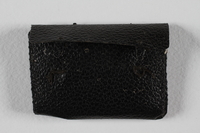Overview
- Brief Narrative
- Pencil sketch of a man owned by Julia Rabinowicz, possibly acquired while she was in the Helenowek children's home. In 1939, the Germans invaded and occupied Poland. The next year, Julia, her parents, Becalel and Solomea, and her sister, Krystyna, were interned in the Jewish ghetto in Łódź. In August 1944, when she was 17 years old, Julia and her mother were deported to Auschwitz concentration camp. Julia was then transferred to the Kratzau labor camp in Czechoslovakia, where she was liberated on May 9, 1945. Her parents perished in the Holocaust. Her sister survived. Julia returned to Łódź after the war and, until 1949, lived in the Helenowek children’s home, operated by the American Jewish Joint Distribution Committee.
- Artwork Title
- Portrait of a Man
- Date
-
use:
1946-1949
- Geography
-
creation:
Helenowek orphanage;
Helenowek (Poland)
- Credit Line
- United States Holocaust Memorial Museum Collection, Gift of Olga Lax
- Contributor
-
Subject:
Julia Rabinowicz
- Biography
-
Julia Rabinowicz was born June 4, 1927, in Łódź, Poland, to Becalel and Salomea Goldkirch Rabinowicz. Salomea, born on January 13, 1890, was a pharmacist. Julia had one older sister, Krystyna, born in 1922. In September 1939, the Germans invaded Poland and occupied Łódź. They established a Jewish ghetto In February 1940,where Julia and her mother were relocated and lived with Maria Rabinowicz, possibly a cousin. In August 1944, Julia and Salomea were deported to Auschwitz-Birkenau concentration camp. Julia was transferred to the Kratzau labor camp in Czechoslovakia. It is likely she was put to work in the ammunition factory; children were often used there because they needed small hands to assemble the grenades. The camp was liberated on May 9, 1945, by Russian forces.
From Kratzau, Julia returned to Łódź and lived in the Helenowek children’s home operated by the American Jewish Joint Distribution Committee. She stayed at Helenowek until 1949. Both her parents were killed but her sister survived. Salomea had been transferred from Auschwitz-Birkenau to Stutthof concentration camp in Poland on September 27, 1944. She was assigned prisoner number 88171 and died there on December 30, 1944.
Julia married Chaim Piotr Gorodecki. He had lived in the Warsaw ghetto until its destruction in summer 1943. He then went into hiding on the Aryan side of Warsaw, and fought in the Warsaw Uprising in August 1944. They had one daughter. The family lived in Warsaw until 1968, when the antisemitic policies of the Polish government prompted them to emigrate to Israel.
Physical Details
- Classification
-
Art
- Category
-
Drawings
- Object Type
-
Portrait drawing (lcsh)
- Physical Description
- Rectangular, light brown paper, with creases from being folded in quadrants. Front has sketch in pencil of an older man in right profile, wearing glasses. He is rotund, has close cut hair, a protruding lower lip, a thick neck, and appears to be wearing a jacket and tie. Back is blank.
- Dimensions
- overall: Height: 5.500 inches (13.97 cm) | Width: 4.000 inches (10.16 cm)
- Materials
- overall : paper, graphite
Rights & Restrictions
- Conditions on Access
- No restrictions on access
- Conditions on Use
- No restrictions on use
Keywords & Subjects
Administrative Notes
- Legal Status
- Permanent Collection
- Provenance
- The drawing was donated to the United States Holocaust Memorial Museum in 2005 by Olga Lax, the daughter of Julia Rabinowicz.
- Record last modified:
- 2023-08-24 13:46:49
- This page:
- https://collections.ushmm.org/search/catalog/irn517354
Download & Licensing
In-Person Research
- By Appointment
- Request 21 Days in Advance of Visit
- Plan a Research Visit
- Request to See This Object
Contact Us
Also in Julia Rabinowicz collection
The collection consists of artifacts, documents, and photographs relating to the experience of Julia Rabinowicz ahd her family during and after the Holocaust. Some of these materials may be combined into a single collection in the future.
Date: 1940-1949

Small leather wallet with buckle used by a teenage girl to hold her diary in a labor camp
Object
Small leather wallet owned by Julia Rabinowicz. She used it to hold miniature notebooks where she wrote about her experiences during the Holocaust. In 1939, the Germans invaded and occupied Poland. The next year, Julia, her parents, Becalel and Solomea, and her sister, Krystyna, were interned in the Jewish ghetto in Łódź. In August 1944, when she was 17 years old, Julia and her mother were deported to Auschwitz concentration camp. Julia was then transferred to the Kratzau labor camp in Czechoslovakia, where she was liberated on May 9, 1945. Her parents perished in the Holocaust. Her sister survived. Julia returned to Łódź after the war and, until 1949, lived in the Helenowek children’s home, operated by the American Jewish Joint Distribution Committee.
Olga Lax papers
Document
The papers consist of a photo album and photographs of Julia Rabinowicz [donor's mother] and her friends in the children's home in Helenowek near Łódź, Poland, from 1946 to 1949; other photographs showing Julia, her sister, Krystyna, and her parents before and during World War II in the ghetto in Łódź; miniature notebooks in a small bag; an autograph book; notes written on birch bark; two documents stating that Julia Rabinowicz has been released from Kratzau (Chrastava), Czechoslovakia, and is returning to her hometown of Łódź; a document issued by the Jewish Historical Institute in Warsaw, Poland, stating that Julia Rabinowicz was imprisoned in the Łódź ghetto and in August 1944 was deported to Auschwitz; and other documents.
Olga Lax collection
Document
Collection of six photographs depicting Hana Gorodecka (donor's paternal grandmother); Julia Rabinowicz's (donor's mother's) friends Zosia and Jurek Flasjszman, who survived together in the Łódź ghetto; Tadek Gothelf, husband of Jadzia Gorodecka (donor's paternal aunt); Sabina Rabinowicz (donor's maternal aunt) who perished; as well as a post-war family portrait of Ida Marzan, a co-worker of Dr. Janusz Korczak.



